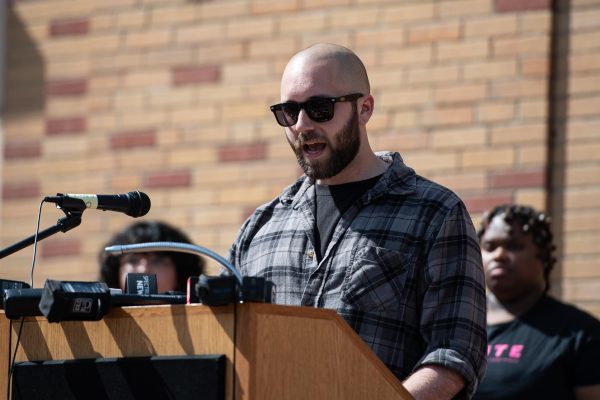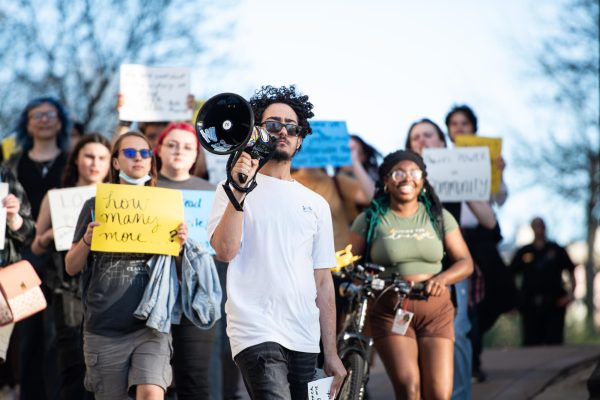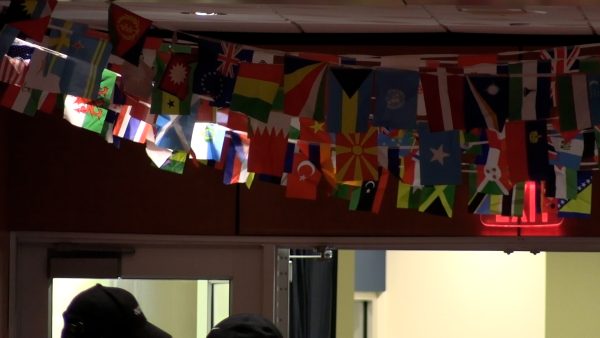Easy as 1-2-3
November 16, 2006
Software puts slides, recorded lectures online
Professor Murali Shanker teaches Fundamentals of Business Statistics using an online lecture program. PHOTOS BY LESLIE CUSANO | DAILY KENT STATER
Credit: Steve Schirra
Associate professor Murali Shanker’s classroom is like most college classrooms. Students take notes as Shanker lectures on the day’s topic. Some students call out answers, while others sit quietly in the back.
The only difference is Shanker uses Lecture123, a program that allows him to record each class lecture and later put it online for students to reference whenever they need.
Lecture123 began as a research project at Rutgers University in 2002, and it went commercial two years later.
Mitch Germansky, the CEO of Lecture123, said one of the goals of the company was to create something that hadn’t been done before but was still easy to use.
“One of our requirements was it had to be easy to use for faculty members because most don’t want to change their methods,” Germansky said.
Shanker teaches Fundamentals of Business Statistics, and as he teaches he is able to add slides to the PowerPoint presentation, pause the lecture, add narration and use pen notation, all of which is recorded by Lecture123.
Students are able to see exactly what he is doing because the notes are projected onto a screen behind him. Even if they miss something, they don’t have to worry.
“I upload it to the server as a podcast, and if you have a video iPod you can download the podcast,” Shanker said. “Even those without iPods can watch the podcast online.”
Junior accounting major Greg Hards said he uses Lecture123 all the time because it helps to “reinforce the lesson.”
“I’ll go back and redo the problems he did in class while I’m just listening to him,” Hards said. “It’s easier without other students in the background.”
Lecture123 is unique because it allows students to play back the lecture when it’s most convenient for them, and it allows them to ask questions.
“We wanted to have a playback session to allow students to play it whenever and wherever they want,” Germansky said.
If students are watching the session online and have a question, all they have to do is click on the slide to ask a question, and Shanker will reply with an answer later via e-mail. This feature helps every student, not just the ones with questions.
“The next person to get online and watch the podcast, they can view the other questions asked by students, along with my answers,” Shanker said.
Although Shanker is the only professor in the College of Business to use Lecture123, he hopes more will start to see its benefits and begin using it.
More than half of Shanker’s 278 students use Lecture123, according to a survey Shanker took earlier in the year. Many tell Shanker they wish other professors would use it.
Even those who don’t use it do not see it as a waste of money.
“It’s a tradeoff because we don’t have to buy the book, which is $80, and the program is $20 so even if you don’t use the program, you’re not wasting money,” said Brandi Heter, sophomore finance and accounting major.
Some teachers worry that if they start using Lecture123, class attendance will decrease, but Germansky said that doesn’t happen.
“The dynamics change in the classroom,” Germansky said. “It becomes more active.”
Germansky said the company is constantly adding new features, and most recently it has added a feature allowing professors to edit podcasts and to send them over cell phones.
“The transformations are happening fast. It’s a very fast market,” Germansky said, referring to the market of eLearning.
Communication between teachers and students no longer takes place in the classroom, and Shanker sees nothing wrong with that.
“I think it’s helping and I don’t see it any different from other forms of communication,” Shanker said. “Face to face is the best form of communication, but electronic communication allows you to see what I have done and think about it.”
Two years from now Shanker may be using a completely different program, but he believes it won’t be hard for students to adjust because using technology is almost second nature to them.
“I think this generation is more comfortable with using electronic communication. You don’t even think about it, you just use it,” Shanker said.
Wherever technology takes the classroom, Shanker just wants to find a happy medium so he can “enrich students’ learning experiences,” which is one goal that doesn’t change — even if the classroom does.
Contact features correspondent Brittany Moseley at [email protected].























